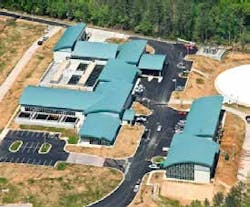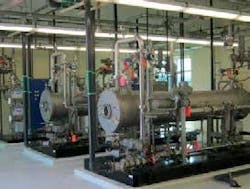In February 2010, the Dempsey E. Benton Water Treatment Plant (DEBWTP) added 16 million gallons per day (MGD) of capacity to the water utility operated by the city of Raleigh, North Carolina. The project, situated on 55 acres in the neighboring town of Garner, North Carolina, represents a milestone in the utility’s history.
Scope
The lack of rain combined with a surging population in Raleigh and the surrounding Research Triangle Park area stretched the existing treatment plant to its limits. Drought conditions lasting from 2005 to 2008 changed the plant’s daily peak demand, especially during the summer months. By 2009, the facility members at DEBWTP started working with an engineering consultant to design a second plant. “It seemed that Raleigh started changing overnight in those years before the new plant,” recalls Kenneth Best, superintendent of Raleigh’s two water treatment plants.
Solution
Drought conditions lasting from 2005 to 2008 caused the porosity of the soil to minimize which resulted in surcharges of run off every time it rained. The DEBWTP needed to handle and treat the increased urban runoff, which was contributing contaminants, organics, and high turbidity, and being discharged into the relatively shallow
Lake Benson. The turbidity alone can reach 120 NTU which played a major factor in the selection, and exclusion, of the plant’s process technologies, according to Shannon Dorsey, PE, associate project manager with Arcadis.
The ozone system is utilized as a multiple purpose extra treatment barrier to reduce the amount of chemicals in the process and enhance the performance of the two-stage filtration system by removing total organic carbon (TOC) and oxidizing iron and manganese in the raw water.
The high-performance WEDECO ozone system at the new plant consists of two ozone generators rated at 700 lbs/day, each operating at 10 percent by weight (% wt.) concentration, equipped with nitrogen boost system. Only one generator is required to be in operation to produce the required ozone dose of 4 mg/L at 20 MGD. There are two 62,380-gallon pre-ozone contactors and twin 9000-gallon LOX tanks. An in-line flash reactor transfers ozone gas to the plant influent via sidestream injection. At the last step of the ozone oxidation process, an offgas ozone destruct unit, one per reactor, converts any residual ozone back into oxygen.
WEDECO UV disinfection was added to the end of the treatment train to enable the plant to move away from exclusively relying on chemical disinfection and allowing the plant to comply with more stringent federal disinfection byproduct requirements.
The plant has three trains (one a standby) rated at 10 MGD each, configured as five rows with 12 lamps in each row.
Result
The DEBWTP is an award-winning model of multiple advanced treatment technologies. Upon completion of the second plant, the city of Raleigh achieved a 40 MGD increased capacity and can handle fluctuations in flow and turbidity levels. The new treatment process reduces the turbidity levels down to 0.07 NTU, significantly less than the state maximum of 0.30 NTU.
Editor's Note: Scranton Gillette Communications and the SGC Water Group are not liable for the accuracy, efficacy and validity of the claims made in this piece. The views expressed in this content do not reflect the position of the editorial teams of Water & Wastes Digest, Water Quality Products and Storm Water Solutions.

